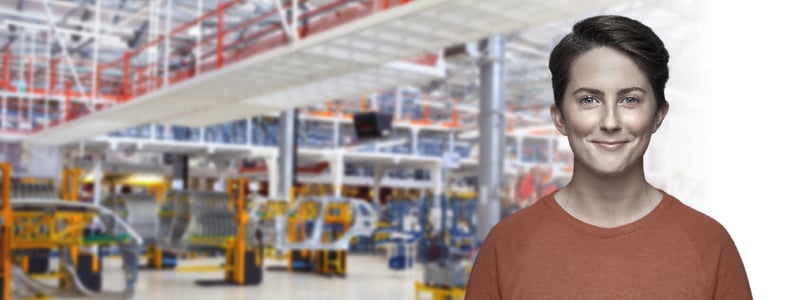As a systems biologist and biomimicry expert by training, and a workforce strategist with many years of experience in manufacturing, I am fascinated by the evolution of systems. In manufacturing, the evolution of automation and on to digital has opened up a frontier that has been awaiting exploration for over 50 years: sustainable manufacturing. More than just the proverbial “green jobs,” sustainable manufacturing as a mindset, process and outcome opens up an incredible world of opportunity for the sector and a promising new chapter for our planet — all of which I will touch on in this blog.
Let me start by establishing a definition of sustainable manufacturing. The U.S. Department of Commerce defines sustainable manufacturing as “the creation of manufactured products that use processes that minimize negative environmental impacts, conserve energy and natural resources, are safe for employees, communities, and consumers and are economically sound.” And why is this important? As major consumers of material resources (natural and manmade) and energy, manufacturing has a tremendous role to play in addressing the impact of climate change. A recent United Nations report warned that CO2 emissions must be cut nearly in half by 2030 to safeguard the planet from additional threats of climate change.
But this is not just about managing climate change. This presents a major opportunity for manufacturers to, as our founder Elmer Winter always said, “do well by doing good.” A 2018 CDP report found that in almost all industries, the costs to realize “green” opportunities are significantly smaller than the total value of the opportunity. In total, the potential value of the opportunities are nearly seven times the costs companies estimate this will take to realize. And the International Labor Organization (ILO) estimates that 24 million jobs worldwide could be created by the green economy by 2030 alone. In fact, we believe that an expanded approach to the original 3P Sustainability Framework of People, Planet, and Profit (which are still core) to include Product/Process and Purpose will give you a holistic view that will give you both internal and external benefit in your organizational and operating model — what we call a 5P ESG model. This approach will also help you understand the full workforce implications of your sustainable manufacturing strategy.
Strategic Drivers of Workforce Evolution in Sustainable Manufacturing
In our Manpower Manufacturing Solutions practice, we look at all workforce evolutions first from the perspective of drivers — these are the strategic opportunities we see converging that set new workforce requirements. This blog is part of a 3-blog series on green manufacturing. In this article, we take a closer look at the kinds of manufacturing roles and skills that will be emerging in the green economy.
Strategic Driver 1: ESG (Environmental, Social and Governance)
An emphasis on ESG — the increased expectation of stakeholders for transparency and accountability in reporting ESG policies and performance — is skyrocketing in boardrooms, community conversations, job choices and shopping carts online and in stores. A great reporting system reporting good performance is the real goal of ESG.
What does it mean to manufacturers and their workforce?
• Identify and align all roles — green and what we call “turquoise” — to their sustainability responsibilities and business opportunities. Turquoise is a new term, so let me tell you a bit more about that. ESG policies, and more importantly the practices they make visible, are built on jobs — especially jobs connected to scientific and technical arenas as well as the those that enable or support green jobs. Manpower calls these jobs “turquoise.” How pervasive are these jobs? According to George Anders of LinkedIn, for every traditional green job posting last year, there were 2.6 non-traditional but related green job postings — that is, adjacent non-science jobs that are needed and require new skills and knowledge driven by increasing sustainable practices and business needs.
• Define how green and turquoise roles will be measured and how their performance and performance reporting can benefit the business, the brand and the operations. This will bring business cases to life and help your organization and people move from a compliance mindset to a value creation mindset.
• Increase the systemic skillset needed. Sustainability skills will be added to most jobs, new and old. For an idea of how pervasive the shared green and turquoise upskilling needs are, Anders’ report states that the average customer service rep position now requires 3.5 green skills. These skills cross all arenas: technical, business and professional. It’s as much about measuring efficiency or alternative energy sources as it is telling compelling stories to gain stakeholder support. We discussed these skills in other blogs and go even deeper in our June 24th webinar.
• Continue to build action-oriented and applied ESG policies, strategies, measures and reporting across the 5P ESG Model.
Strategic Driver 2: Resource and Material Management
Resource and material management has become increasingly important as global raw materials become more difficult and expensive to source and alter natural systems, often for the long term, without regenerative strategies. According to the U.S. Environmental Protection Agency (EPA), materials management is associated with an estimated 42 percent of total U.S. greenhouse gas emissions. Material inventories and sources change for natural, social and governance reasons; resources deplete, consumers shift, nationalistic interests expand, all while dynamic and cyclical demand requires options, especially increased demand for nature's direct and indirect contributions. The EPA also reports that global raw material use rose during the 20th century at about twice the rate of population growth. For every 1 percent increase in gross domestic product, raw material use has risen by 0.4 percent.
What does it mean to manufacturers and their workforce?
• Consider and include roles that can excel in this arena: from eco-conscious materials engineers and process engineering teams, upskilled testers and validation techs, to packaging professionals to quality specialists (For more on the changing arena of Quality, read my colleague Rebekah Kowalski’s blog, Quality’s Bright and Bold Future.)
• Make processes and related skills the focus of these roles — especially the ability to take a full-life cycle and closed-loop approach to materials management (from design to sourcing to restoration). This will at the least decrease the reliance on raw materials, lower disposal costs and land damage as upcycling expands, and add in innovation and new designs. This all leads to reduced environmental impact and cost of materials and improved living conditions.
Strategic Driver 3: Innovation and Biomimicry
Manufacturing for all of its public relations issues (i.e., “dark and dirty”) is actually ripe with and for innovation. There is much opportunity to blend the digital and mechanical in another relationship: the one with nature, its natural resources, environment, and life forms. An endless source of innovation for manufacturers on forms, structures, processes, and strategies, the natural world deserves more consideration as a source for inspiration, not just utilization.
Biomimicry, the practice of observing then modeling nature's strategies to solve human and “built world” challenges, offers a path to healthy profit while working in partnership, and even reciprocity, with the natural world. There are thousands of examples in our everyday life already. Observing burs from a burdock plant tangle with dog fur led to Velcro®; high-speed train noise problems were solved by emulating bird beaks; honeycomb designs increased lithium battery space efficiency; and observing ant traffic patterns made truck routes more efficient. Endless sustainable opportunities are ahead as sustainable manufacturers incorporate more biomimicry into their thinking and doing.
What does it mean to manufacturers and their workforce?
Looking to nature for inspiration draws on 3.8 billion years of systems genius. There are endless examples of mutually beneficial systems, material forms and functions, process innovations and designs to draw upon. The natural world can be a role model for succeeding across the 5P ESG Model — both today and into the future.
• Go beyond conventional core science or environmental science positions and learn how innovative "bio-business" roles and expertise can supplement your designs and processes. Hire more biologists, ecologists and other natural science experts and give them a seat at the table — in Operations, IT, and Business.
• Encourage integrated domain teams for your projects. Change up and expand what interdisciplinary means but always include eco, bio, and ethical development experts too.
• Remember to leverage bio-wisdom and nature's success strategies for sustainable people and culture practices as well. When it comes to social innovation and business ecosystems, nature can inform how we think about networked management strategies, symbiotic social relationships, upcycled skillsets, stronger structures, better flowing supply chains and more that have all shown sustainable outcomes.
The road to sustainability hasn’t been easy. The impetus to invest in new processes and technologies often encounters resistance. Workers in traditional sectors fear for their jobs, and business cases for change can be inconsistent or incomplete and stall needed change. There are still essential conversations and work to do. The direction of change is clear, and it’s time to be planful about changing to sustainable manufacturing and workforce strategies. Manpower Manufacturing will be sharing our research on the changing landscape of roles and skills over the coming months to help you color your strategies green and turquoise, and deliver on the promise of green/sustainable futures while offering new opportunities at individual, business and social scale.
Hear more about how advances in green manufacturing is impacting future roles and skills by tuning in to our webinar Shades of Green Manufacturing.


.jpg?length=800&name=MP_SkilledTechTempPermBanner10_5_22%20(1).jpg)

Comments